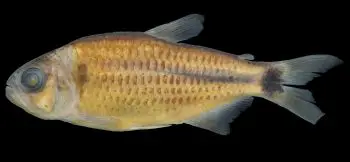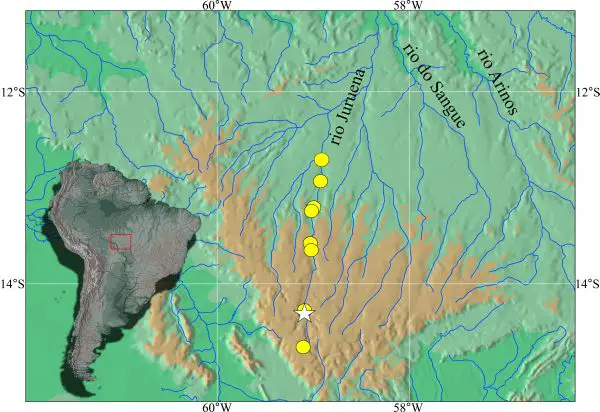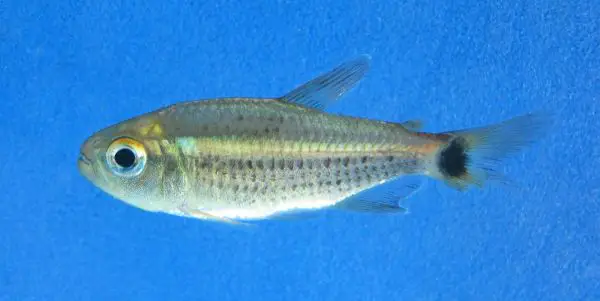New species appears closely related to red eye tetra

MZUSP 117108, 67.9 mm SL, holotype of Moenkhausia lineomaculata, Brazil, Mato Grosso State, Campos de Júlio, rio Juruena, upper rio Tapajós basin. © Fernando C. P. Dagosta
The genus Moenkhausia is among the most diverse within the family Characidae, with almost 80 species included at present, although it is in need of extensive taxonomic revision. Recent phylogenetic analyses have revealed the to represent a polyphyletic assemblage, with at least five distinct lineages recognised, some of which also contain members of other incertae sedis genera such as Hemigrammus or Hasemania.
One of these putative groups is referred to as the Moenkhausia oligolepis/M. sanctaefilomenae complex, and includes species sharing a reticulated colour pattern formed by dark posterior scale borders on the body, a vertically-elongate humeral blotch, a dark caudal peduncle blotch preceded by a lighter area, and often a red eye. Currently included are M. cosmops, M. cotinho, M. diktyota, M. forestii, M. oligolepis, M. pyrophthalma and M. sanctaefilomenae, among which the latter is a popular aquarium fish commonly referred to as ‘red eye tetra’.
New species M. lineomaculata Dagosta, Marinho, & Benine 2015 is the latest addition to the group, and can be distinguished from all other members, except M. cotinho, by the presence (vs. absence) of longitudinal rows of dark spots on the body. It differs from M. cotinho by possessing an evenly-pigmented (vs. darker dorsally) humeral blotch, and a thin dark midlateral stripe originating beneath the dorsal-fin insertion (vs. originating posterior to the humeral blotch). The number of pored lateral line scales is variable, a rare trait in characids but present in some other members of the Moenkhausia oligolepis/M. sanctaefilomenae complex.

Distribution map of Moenkhausia lineomaculata (yellow dots) in the upper rio Juruena basin, Brazil. White star
symbol represents the type locality. © Fernando C. P. Dagosta
M. lineomaculata is known only from the rio Juruena watershed within the upper rio Tapajós basin, Mato Grosso State, Brazil, where it occurs sympatrically with M. cotinho.
Matt Ford
For additional information see the full paper (link to abstract only): Dagosta, F. C. P., M. M. F. Marinho, and R. C. Benine, 2015. A new species of Moenkhausia Eigenmann (Characiformes: Characidae) from the upper rio Juruena basin, Central Brazil. Zootaxa 4032(4): 417-425.
Thanks to Fernando C. P. Dagosta.
Category: New Species, News | Tags: Dagosta, Moenkhausia, red eye tetra, sanctaefilomenae, Zootaxa | One comment »


January 26th, 2016 at 7:11 am
Hi Guys,
I just joined seriouslyfish.
Wish you all eventful days. Form your information, IUCN Bangladesh is updating the Red List of a few groups of animals including Fish. The Red List will be published in March 2016. Among the fish documented in Bangladesh, we do not have good photos of the following species. I wonder, if any of you have the photos of these fishes and kindly allow us to use the photos in the upcoming Red List (web version and hardcopy book). The photos will be duly credited to you. It would be appreciated, if you reply me by your earliest convenience through seriouslyfish or to my email – [email protected]
Thank you all.
Pseudogopiopsis oligactis
Ilisha filingera
Labeo nandina
Osteochilus hasseltii
Nangra ornate
Pseudecheneis sulcata
Pseudolaguvia inornata
Pseudolaguvia muricata
Laubuca brahmaputraensis
Nangra bucculenta
————-
mostafa